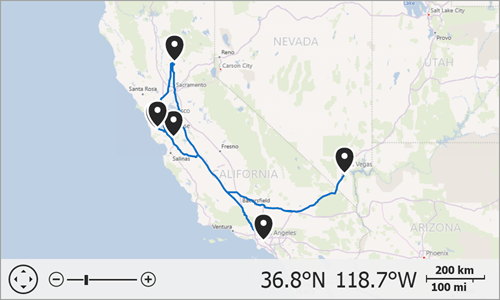BingRouteOptions.OptimizeWaypoints Property
Specifies whether the service rearranges route waypoints to reduce route cost.
Namespace: DevExpress.XtraMap
Assembly: DevExpress.XtraMap.v21.1.dll
NuGet Packages: DevExpress.Win.Design, DevExpress.Win.Map
Declaration
Property Value
| Type | Default | Description |
|---|---|---|
| Boolean | **false** | true if waypoints are rearranged; otherwise, false. |
Property Paths
You can access this nested property as listed below:
| Object Type | Path to OptimizeWaypoints |
|---|---|
| BingRouteDataProvider |
|
Remarks
Enable the OptimizeWaypoints property to rearrange waypoints passed to the BingRouteDataProvider.CalculateRoute method to create an optimized route.
The following images depict non-optimized and optimized routes for six waypoints (“San Francisco”, “Las Vegas”, “San Jose”, “Chico”, “Los Angeles”, “Oakland”):
- OptimizeWaypoints = false

- OptimizeWaypoints = true

The OptimizeWaypoints option is available only for Driving mode (Mode is set to Driving). The list of waypoints should include more than 2 points.
Example
The following code creates an optimized route for a list of waypoints:
using DevExpress.XtraMap;
using System;
using System.Collections.Generic;
using System.Drawing;
using System.Windows.Forms;
namespace RouteCalculationSample {
public partial class Form1 : Form {
private void Form1_Load(object sender, EventArgs e) {
// Create a background image layer.
ImageLayer imageLayer = new ImageLayer();
imageLayer.DataProvider = new BingMapDataProvider {
BingKey = "Insert your Bing key.",
Kind = BingMapKind.RoadLight
};
mapControl1.Layers.Add(imageLayer);
// Create an information layer and add it to the map control.
InformationLayer infoLayer = new InformationLayer();
mapControl1.Layers.Add(infoLayer);
// Create a BingRouteDataProvider.
BingRouteDataProvider routeProvider = new BingRouteDataProvider();
// Specify the provider's Bing key.
routeProvider.BingKey = "Insert your Bing key.";
// Create a list of waypoints.
List<RouteWaypoint> waypoints = new List<RouteWaypoint>() {
new RouteWaypoint("San Francisco", new GeoPoint( 37.4639, -122.2459)),
new RouteWaypoint("Las Vegas", new GeoPoint( 36.1030, -115.0811)),
new RouteWaypoint("San Jose", new GeoPoint( 37.20, -121.54)),
new RouteWaypoint("Chico", new GeoPoint(39.4424, -121.508)),
new RouteWaypoint("Los Angeles", new GeoPoint( 34.03, -118.15)),
new RouteWaypoint("Oakland", new GeoPoint( 37.4816, -122.1615))
};
// Notify the provider that the requested route should be optimized.
routeProvider.RouteOptions.OptimizeWaypoints = true;
// Enable Driving mode.
routeProvider.RouteOptions.Mode = BingTravelMode.Driving;
// Calculate the route for specified waypoints.
routeProvider.CalculateRoute(waypoints);
// Handle the LayerItemsGenerating event to customize the route polyline appearance.
routeProvider.LayerItemsGenerating += OnLayerItemsGenerating;
// Assign the provider to the information layer.
infoLayer.DataProvider = routeProvider;
infoLayer.DataRequestCompleted += OnDataRequestCompleted;
}
private void OnLayerItemsGenerating(object sender, LayerItemsGeneratingEventArgs e) {
foreach (MapItem item in e.Items) {
MapPolyline polyline = item as MapPolyline;
if (polyline != null) {
polyline.Stroke = Color.FromArgb(0xFF, 0x00, 0x72, 0xC6);
polyline.StrokeWidth = 4;
}
}
}
private void OnDataRequestCompleted(object sender, RequestCompletedEventArgs e) {
// Call the ZoomToFitLayerItems method to zoom the map so that it displays the whole generated route.
mapControl1.ZoomToFitLayerItems(0.4);
}
}
}